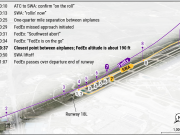The number of serious runway incursions at U.S. airports has declined dramatically over the past nearly 20 years, but has been trending higher since 2013, according to Federal Aviation Administration (FAA) statistics.
A runway incursion, according to FAA and the International Civil Aviation Organization, is any unauthorized presence on a runway, regardless of whether an aircraft, vehicle or pedestrian presents a potential conflict with another aircraft authorized to land, take off or taxi on a runway.
There are four categories of incursions, with A and B being the most serious. FAA defines a Category A incursion as a serious incident in which a collision was narrowly avoided. Category B is defined as an incident in which separation decreases and there is a significant potential for collision that may result in a time-critical corrective/evasive response to avoid a collision.
In fiscal year 2000, which ended on Sept. 30, 2000, there were a total of 67 Category A and B incursions, of which 43 involved commercial aircraft. In fiscal year 2010, the number of Category A and B incursions declined to six, with three involving commercial aircraft. Since then, the annual number of A and B incursions has ranged from 11 in 2013 to 19 in fiscal year 2016, with year-over-year increases in each of the last three years. As of Aug. 7, there have been six A and B incursions so far in fiscal 2017, and two of them have involved commercial aircraft. The vast majority of incursions fall into Categories C and D and pose no risk of collision, FAA said
Reducing runway safety risk is a priority for FAA, and one of the ways the agency is working on that issue is through the development of runway status light (RWSL) technology, which is intended to increase situational awareness for aircrews and airport vehicle drivers and to serve as an additional layer of safety. RWSLs currently are operational at 11 large U.S. airports, including Los Angeles International, Washington Dulles, George Bush Intercontinental (Houston) and Orlando International. FAA says that nine more airports, including Chicago O’Hare International, Dallas-Fort Worth International and John F. Kennedy International in New York, are in various stages of site-acceptance testing, construction or implementation and should be operational by the end of fiscal year 2017 on Sept. 30.
According to FAA, an RWSL system derives traffic information from surface and approach surveillance systems and illuminates red in-pavement airport lights to signal a potentially unsafe situation. Runway entrance lights are deployed at taxiway/runway crossings and illuminate if it is unsafe to enter or cross a runway. Takeoff hold lights illuminate red when there is an aircraft in position for departure and the runway is occupied by another aircraft or vehicle and is unsafe for takeoff.


